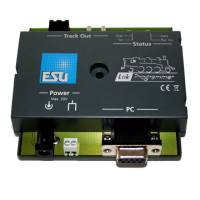6
LokSound Basics
3.1.3. Diesel locomotive (diesel-hydraulic)3.1.3. Diesel locomotive (diesel-hydraulic)
3.1.3. Diesel locomotive (diesel-hydraulic)3.1.3. Diesel locomotive (diesel-hydraulic)
3.1.3. Diesel locomotive (diesel-hydraulic)
The main item of equipment of a diesel-hydraulic locomotive is
the torque-converter that uses fluids for power transmission.
This energy flow is literally „fluent.“
That is the reason why diesel-hydraulic locomotives howl audibly
once the throttle is opened and before the locomotive is actually
moving. Since the revs of the motor sound depend on the
speed, the noises generated during driving change without
audible thresholds. Simply put, the sound is directly proportio-
nal to the speed.
Locomotives with LokSound decoders behave the same way;
first the diesel engine revs up and once the revs are high
enough the locomotive starts moving. The pitch of the sound
can be adjusted subject to the speed. This is only possible in a
combined unit (decoder plus sound module in one piece – for
further info also refer to chapter 8.5.4).
ExamplesExamples
ExamplesExamples
Examples for diesel-hydraulic locomotives are the DB class V200
(class 220) and the Regio-Shuttle or the DMU41 by the SNCB/
NMBS.
Fig.6.: Performance of a Diesel-hydraulic Locomotive
3.1.4. 3.1.4.
3.1.4. 3.1.4.
3.1.4.
Diesel locomotive with manual transmissionDiesel locomotive with manual transmission
Diesel locomotive with manual transmissionDiesel locomotive with manual transmission
Diesel locomotive with manual transmission
(manual gear gear box)(manual gear gear box)
(manual gear gear box)(manual gear gear box)
(manual gear gear box)
Diesel locomotives with manual transmission employ pinion gear
for transmitting the power from the motor to the wheels
similar to automobiles. The clutch is pressed during shifting
from one gear to the next and thus the power transmission is
interrupted for a short moment. The shifting of gears can
clearly be heard in many a diesel locomotive with manual
transmission. With the LokProgrammer software you can either
store the original sound of gear shifting or you may choose the
option „gear shift“ (User-Sound Slot 14) as described in chapter
9.6.2:
ExamplesExamples
ExamplesExamples
Examples of diesel locomotives with manual transmission are
the German rail cars VT95 or some shunting locomotives, since
manual transmissions are only practical in vehicles of relatively
low weight and with low maximum speeds.
Fig.7.: Performance of a Diesel Locomotive with Manual Transmission
3.1.5. Electric locomotive3.1.5. Electric locomotive
3.1.5. Electric locomotive3.1.5. Electric locomotive
3.1.5. Electric locomotive
There are different sound types for electric locomotives. On
the one hand the hum of the electric traction motor(s) is audible;
it changes its pitch with the speed similar to diesel-hydraulic
locomotives.
Other electric locomotives generate very dominant fan sounds.
In some electric locomotives the sound of the fan is constant
and therefore the sound does not change during driving.
By and large electric locomotives are not as noisy as other
locomotive types and therefore they are ideal for applying
User Sounds such as the whistle, horn, compressor, etc. (for
more info please refer to chapter 9.5 and 9.6).
Fig.8.: Performance of an Electric Locomotive
3.2. User defined sounds3.2. User defined sounds
3.2. User defined sounds3.2. User defined sounds
3.2. User defined sounds
User-defined sounds („User-Sounds“)
could be horns and whistles, coupler clank,
sanding, etc. These sounds can be
triggered by pressing a function button
on your throttle once you have
programmed them onto the decoder.
Currently LokSound decoders support up
to 16 functions such as head lights, smo-
ke generator, etc. The latest versions of digital command
stations such as the ESU ECoS can fully utilize this range.

